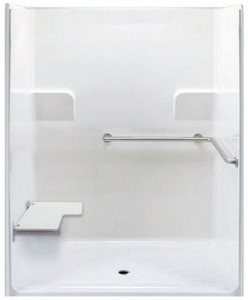Tips for ADA-Compliant Bathroom Remodeling
October 28, 2014
 The American With Disabilities Act (ADA) aims to help individuals with disabilities by removing physical, social and technical barriers that prevent them from engaging in the same activities that people without disabilities enjoy. Among other things, ADA applies to bathroom design and construction, setting standards for handicap-accessible bathrooms and restrooms. Today, our commercial bathroom remodeling specialists will discuss how to ensure ADA compliance when it comes to bathroom remodeling.
The American With Disabilities Act (ADA) aims to help individuals with disabilities by removing physical, social and technical barriers that prevent them from engaging in the same activities that people without disabilities enjoy. Among other things, ADA applies to bathroom design and construction, setting standards for handicap-accessible bathrooms and restrooms. Today, our commercial bathroom remodeling specialists will discuss how to ensure ADA compliance when it comes to bathroom remodeling.
Do You Have to Comply?
ADA specifies which “covered entities” should comply with its regulations. Besides state and local government facilities, this list includes most places of public accommodation, such as:
- Private and public entities offering exams and educational courses: college campuses and public schools.
- Lodging facilities: hotels, motels, hostels, nursing and retirement homes, etc.
- Correctional facilities
- Recreational and entertainment facilities: restaurants, theaters, shopping centers, museums, etc.
- Healthcare facilities: hospitals, doctor’s offices, pharmacies, etc.
- Commercial facilities: office buildings, warehouses, factories, etc.
Essentially, if the building you own is open to the general public, engages in commerce or you employ more than 15 employees, it’s likely you have to comply with the ADA requirements in making your bathrooms accessible for people with disabilities. One big exception, however, are apartment complexes and other housing units that are limited only to tenants and their guests and don’t engage in commerce. But even if your facility doesn’t HAVE to comply with the ADA requirements, it doesn’t mean you shouldn’t. Bringing your bathrooms to the ADA standards will help you serve even more costumers who otherwise wouldn’t be able to use your facility.
How Old is Your Building?
The original ADA regulations came into effect in 1991 and applied to all buildings built after 1993. In 2010, ADA released a new set of standards that are currently in effect. If your facility hasn’t been remodeled between 2010 and now, then you likely fall under the “safe harbor” provision that says you don’t have to ensure compliance with the new standards if the old ones were followed correctly. But if you decide to remodel your 1991-compliant bathrooms, you now have to follow the 2010 regulations.
What are the ADA Standards for Bathrooms?
As you can see, there are many nuances when it comes to ensuring ADA compliance in bathrooms. That’s why it helps to hire a Maryland ADA bathroom remodeling company that knows the laws and specializes in accessibility remodeling. Here are some of the things that ADA regulates under Section 213 of the 2010 Standards in regard to bathroom design and construction:
- shower and bathtub seats
- shower curtains
- mirrors and medicine cabinets
- grab bars
- clear floor and rotating space
- toilet paper holders
- soap dishes and soap dispensers
- paper towel dispensers and hand dryers
- waste receptacles
- faucets and bath/shower controls
- door space
- signage
For most of these items, the ADA specifies exact type, dimensions and location. Interestingly, the regulations don’t go into much detail about the type of bathtub used, aside from it having a seat. While walk-in bathtubs are not required by the ADA, many of our clients find it easier to install a tub with built-in seating, grab bars and accessible controls, rather than modifying their existent outdated bathtub.
Are you looking for a company that can guide you through the bathroom remodeling process and ensure ADA compliance? Ward Enterprise serves clients in many industries, including hospitality, student and senior housing, performing ADA bathroom installations in Maryland, Virginia and Pennsylvania. Contact us today to discuss how we can help you with your project.
